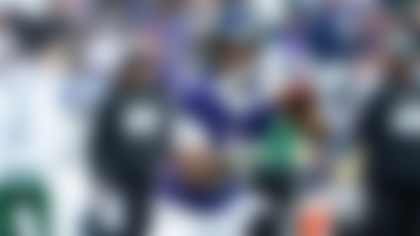*Now that there are 50 Super Bowls in the books, Dave Dameshek -- with the help of Elliot Harrison and Gil Brandt -- is taking a look at how our perception of superior quarterback play has evolved in the Super Bowl era, using every 10th Super Bowl as a check-in point. Over the next week, we'll be presenting the top 10 quarterbacks as of Super Bowl X, Super Bowl XX, Super Bowl XXX, Super Bowl XL and Super Bowl 50 before wrapping things up with a speculative look at the list after the clock runs out in Super Bowl LX. *
Here's the thing: A lot changes over a half-century. Like pro football, for instance.
Now, I could spend the next several hours counting the ways, but to save us -- or, at least, me -- some time, lemme just share this list:
53) Joe Flacco, 28,322 yards, 2008-2015
54) Ron Jaworski, 28,190 yards, 1974-1989
55) Terry Bradshaw, 27,989 yards, 1970-1983
56) Ken Stabler, 27,938 yards, 1970-1984
57) Craig Morton, 27,908 yards, 1965-1982
58) Joe Namath, 27,663 yards, 1965-1977
59) Jeff George, 27,602 yards, 1990-2001
Yes, 31-year-old periodically "elite" quarterback Joe Flacco has more career passing yards than Hall of Famers Terry Bradshaw, Ken Stabler and Joe Namath. (On the bright side for those guys, at least they were able to hold off Jeff George and his mullet.)
What's this tell us? (I hope and trust you've already figured it out, but ...) 21st-century QBs throw the ball a LOT more than their predecessors. They're also more accurate, throw more TDs and fewer interceptions and post more 300-yard games than Kanye's wife posts nude pics. At the dawn of the Super Bowl era, running backs were more important to most NFL offenses than QBs. However, by the time the first X big games were in the books, things had ever so slightly started to change. Of course, as the list above shows, it's continued to evolve ... which brings us to this:
Our attempt to rank the best quarterbacks of the Super Bowl era -- in 10-year increments.
We'll start in January of 1976, just after the Steelers won their second straight Lombardi Trophy by beating the Cowboys in Super Bowl X -- then jump a decade ahead to see how our assumptions have changed, checking in every 10 Super Bowls until we take a look forward to Super Bowl LX. The difficulty with this project -- especially with this first 10-year period -- is evaluating Hall of Famers who predate the Super Bowl era, but let's apply this standard: In order for a QB to be eligible for this list, he must have played in the 1966 season (the first season that ended with a Super Bowl) or beyond. Fairly or not, we feel compelled to ding the legends whose best seasons came before '66, especially as we get further away from the run-dominant era. Matter of fact, I suspect you'll be surprised by some of the names here ... until you consider who the alternatives were.
Before we dig into my rankings, let's take a look at how two of my NFL Media colleagues -- Elliot Harrison, who has a special affinity for NFL history, and Gil Brandt, who didn't just see these guys play, but actually scouted most of them -- ranked their quarterbacks, along with how the numbers say they stack up (according to passer rating from 1966 through the 1975 season):
Top 10 Quarterbacks Between Super Bowls I and X (Jan. 1976):
Elliot Harrison's list:
1) Johnny Unitas
2) Bart Starr
3) Len Dawson
4) Sonny Jurgensen
5) Joe Namath
6) Fran Tarkenton
7) Don Meredith
8) Roger Staubach
9) Bob Griese
10) Daryle Lamonica
Gil Brandt's list:
1) Bart Starr
2)Roger Staubach
3) Johnny Unitas
4) Len Dawson
5) Joe Namath
6) Daryle Lamonica
7) Bob Griese
8) Ken Stabler
9) Terry Bradshaw
10) Fran Tarkenton
By the numbers (according to passer rating):
1) Sonny Jurgensen (85.7)
2) Ken Anderson (85.5)
3) Bart Starr (82.8)
4) Don Meredith (82.6)
5) Fran Tarkenton (82.5)
6) Len Dawson (81.3)
7) Ken Stabler (80.7)
8) Roger Staubach (79.9)
9) Bob Berry (77.3)
10) Earl Morrall (76.8)
Now, without further ado, my top 10 quarterbacks through Super Bowl X:
1) Johnny Unitas
With all due respect to Sammy Baugh and Otto Graham, Johnny U was regarded as the best QB in history by the time the first "AFL-NFL World Championship Game" was played in January of 1967 -- but he was well past his prime. Nevertheless, he was able to further entrench himself as the G.O.A.T. over the ensuing decade (through January 1976, remember) with the '67 MVP and a trip three years later to Super Bowl V as the Baltimore Colts' starting QB. And while Joe Namath rightly gets credit for the biggest win of the Super Bowl era (Super Bowl III, of course), Unitas claims this spot because, according to those who saw him play, pro football might never have sufficiently been elevated to a place requiring something like a Super Bowl without No. 19.
2) Roger Staubach
The starting QB of the Super Bowl champion Dallas Cowboys in the 1971 season, Captain Comeback was a full-on hero in Big D circa January '76, even though he and his teammates had just lost to Pittsburgh in Super Bowl X. Lots of "what ifs" loom here: What if he hadn't spent his first four post-college years in the Navy? What if he'd been healthy throughout '72 and led Dallas to the Super Bowl vs. the undefeated Dolphins? What if he'd beaten the Steelers in X? The answer to all three: He'd be ranked No. 1 on this list.
3) Bart Starr
The 9-1 lifetime postseason performer was winding down his legendary run with Lombardi and Co. by 1966 ... but he and his team still had enough left in the tank in the Super Bowl era to knock off the (NFL's second-best) Dallas Cowboys in both '66 and '67, before whipping AFL champions Kansas City and Oakland in less-than-significant Super Bowl showdowns. (Noteworthy, too: In the run-heavy GB offense, Starr still completed 65 percent of his passes for 1,169 yards, 10 TDs and just two picks in the five postseason games the Pack won during those two Super Bowl runs.)
4) Fran Tarkenton
It's hard to believe here in 2016, but Tarkenton -- who split time during the decade in question between the Minnesota Vikings and New York Giants -- is still ranked in the top 10 in all-time passing yards (No. 8, with 47,003) in spite of being the only QB in that top-10 group whose career ended before the start of the 1980s (let alone 1998, when John Elway, currently No. 6 all time, hung 'em up). Yeah, he didn't win the big one, but he lost to three great foes -- the Dolphins in VIII, the Steelers in IX and the Raiders in XI -- and he was able to scramble Minnesota past some great Dallas, Washington and L.A. teams just to get to those games.
5) Joe Namath
As of January 1976, Broadway Joe was still a little over a year away from putting on a Rams helmet for the '77 season, his one and only non-Jets campaign. Cynics call him overrated, (rightly) pointing to his career 220 interceptions against 173 touchdown passes, but like Gale Sayers, the '68 and '69 AFL MVP was all-world until the toll of repeated knee injuries stole potentially gargantuan career numbers. (But by the way, he still put up some pretty lofty stats even in those bum games, twice leading the AFL in passing yards, then leading the NFL in passing yards and TDs in '72.)
6) Sonny Jurgensen
If you're asking "Who?" please know the pretentious football snob in me resents you. To be honest, though, I've only really seen portions of a handful of his games -- but even that limited exposure is enough to teach me Jurgensen had one of the NFL's great arms. Unlike some of the others listed here, the Redskins quarterback had some huge statistical seasons during the decade on which we're focused (leading the NFL in passing yards three times and TD passes once).
7) Len Dawson
The steady mainstay for the AFL's best defense, Dawson was a precise passer who led the AFL or NFL seven times in completion percentage (including '66 through '69) and, more importantly, helped take his Kansas City Chiefs to the first Super Bowl and the fourth. After the latter, Dawson was named the game's MVP in a winning performance.
8) Terry Bradshaw
The 1970 No. 1 overall draft pick had yet to fully hit his professional stride by January '76, but he was still good enough to become the third QB to win two Super Bowl rings (during a decade that included the Dolphins, Raiders, Cowboys and Vikings ... a.k.a. some of the best teams ever). Of course, he benefitted from the sport's best-ever defense and the Steelers' rugged running attack, but, as you may note, it's not like any of the other crowned princes on this list were surrounded by pauper-filled rosters.
9) Earl Morrall
He spent more time as a backup than starter, but Morrall was still able to leave his mark during the Super Bowl's first decade -- beginning in '68, when he took the Baltimore Colts to Super Bowl III and led the NFL in TD passes with 26. He moved to Miami in '72, just in time to fill in for the injured Bob Griese for nine wins in the team's undefeated season. Speaking of Griese ...
10) Bob Griese
All right, fine, he was savvy enough to not make many mistakes on the rare occasions Don Shula asked him to throw during the Dolphins' dominant run in the early '70s, but let's not jive: Even compared to his peers in the 1966-75 timeframe, Griese handed the ball off A LOT. To his credit, he won two Super Bowls and went to three straight, so we're obliged to list him over John Brodie, John Hadl and Daryle Lamonica.
Follow Dave Dameshek on Twitter @Dameshek.












